|
|
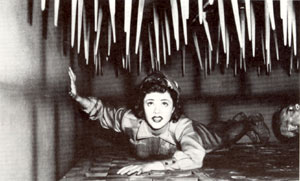 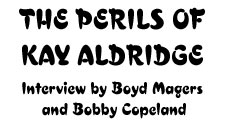
Kay Aldridge starred in three of the most exciting serials ever produced by the studio known for its action films, Republic. Kay was a delightful and charming performer, wore a constant smile, and enjoyed answering questions and attending film festivals.
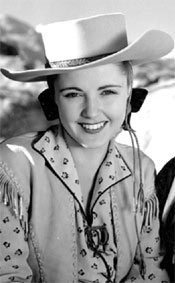 SR: Where were you born? SR: Where were you born?
KA: I was born in Tallahassee, FL, on July 9, 1917.
SR: What type of work did your father do?
KA: My parents were Virginians and my father was a surveyor. I never knew him for he died when I was two years old. My mother was widowed, had five children and very little money, so she returned to my great aunts’ home in Virginia. My great aunts were wonderfully educated old maid schoolteachers and my mother was an artist and writer. My childhood, while impoverished, was very, very good and I enjoyed it. I went to Hollywood after I was a John Powers model in New York and was ‘discovered’ there.
SR: Did you complete high school in Virginia?
KA: Yes, I graduated in 1934 and started to pursue a career as a model.
SR: How did you get into films?
KA: It was really through my modeling. In 1937, I was chosen as one of the ten most photographed girls in the world. Some of the girls were selected to go to Hollywood to appear in the film “Vogues of 1938” (‘37 U.A.). That was my first film.
SR: How did you get started making those exciting serials?
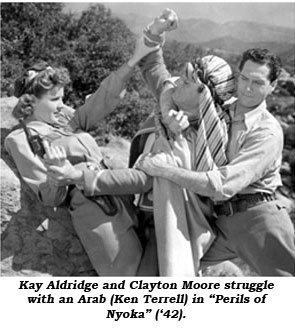 KA: My contract with 20th Century Fox expired in ‘41, and they chose not to renew it. Republic approached me about the serials. I did it with the attitude we had in that day that to make a B-western or a serial was a comedown for a featured player at Fox. It was a comedown in one way, but it was a comeup in another way because I was the lead. They paid me about $650 a week, which was pretty good money at the time. My first serial was “Perils of Nyoka”. I played Nyoka in 1942 and my name has been associated with that role ever since. Nyoka was such a departure to me from what I’d been doing before that I considered it a great romp—actually a pretty rough romp. I pretended to be more of an outdoor woman than I was. I knew how to ride, but they put me on a horse that was much too wild for me. The first day on “Perils of Nyoka”, the horse reared up and threw me over his head toward the sound truck, with my face coming at the sound truck. But some property man gave me a push so my face didn’t get smashed into the sound truck. I got kinda bruised and everything, so after that they brought Davey Sharpe in for some of those moments I wasn’t quite equal to. David Sharpe had muscular, knotty legs with black hair and a small mouth on which he painted a sloppy lipstick job and stuck a cigar in the middle of it. He put his wig on that looked like a raggy version of my Nyoka hairdo. His walk was masculine. I didn’t know about serials and stunt men, and I was so afraid there’d be some shots of him people would really think I was built like that. I thought my double had to be prettier. Davey was a great stunt man. He did all the dangerous scenes. He doubled almost everyone. It was also hard for me, because serials weren’t shot in sequence. They do everything in the Cave of the Evil Bird one day—and the next day you’re in bubbling oil actually before you’ve been thrown in. So, you get very confused. The dialogue is very sketchy. You can have delivered your line very badly, but they won’t reshoot it unless the horse happens to simultaneously make a social error. (Chuckles) That’s about the only reason for a retake on a serial. So we had to be one-take people and ready to roll. While at 20th Century Fox we’d wait all day to say one line. I wish I’d done the serials first, then been in A movies, I might have been a little better actress in the earlier films. I tried my best, but it was very hard to learn to be an actress in serials…I think the people who come across as really holding the serial together are the fine old actors and the experienced people in small parts. I think Lorna Gray was a much better actress than myself. KA: My contract with 20th Century Fox expired in ‘41, and they chose not to renew it. Republic approached me about the serials. I did it with the attitude we had in that day that to make a B-western or a serial was a comedown for a featured player at Fox. It was a comedown in one way, but it was a comeup in another way because I was the lead. They paid me about $650 a week, which was pretty good money at the time. My first serial was “Perils of Nyoka”. I played Nyoka in 1942 and my name has been associated with that role ever since. Nyoka was such a departure to me from what I’d been doing before that I considered it a great romp—actually a pretty rough romp. I pretended to be more of an outdoor woman than I was. I knew how to ride, but they put me on a horse that was much too wild for me. The first day on “Perils of Nyoka”, the horse reared up and threw me over his head toward the sound truck, with my face coming at the sound truck. But some property man gave me a push so my face didn’t get smashed into the sound truck. I got kinda bruised and everything, so after that they brought Davey Sharpe in for some of those moments I wasn’t quite equal to. David Sharpe had muscular, knotty legs with black hair and a small mouth on which he painted a sloppy lipstick job and stuck a cigar in the middle of it. He put his wig on that looked like a raggy version of my Nyoka hairdo. His walk was masculine. I didn’t know about serials and stunt men, and I was so afraid there’d be some shots of him people would really think I was built like that. I thought my double had to be prettier. Davey was a great stunt man. He did all the dangerous scenes. He doubled almost everyone. It was also hard for me, because serials weren’t shot in sequence. They do everything in the Cave of the Evil Bird one day—and the next day you’re in bubbling oil actually before you’ve been thrown in. So, you get very confused. The dialogue is very sketchy. You can have delivered your line very badly, but they won’t reshoot it unless the horse happens to simultaneously make a social error. (Chuckles) That’s about the only reason for a retake on a serial. So we had to be one-take people and ready to roll. While at 20th Century Fox we’d wait all day to say one line. I wish I’d done the serials first, then been in A movies, I might have been a little better actress in the earlier films. I tried my best, but it was very hard to learn to be an actress in serials…I think the people who come across as really holding the serial together are the fine old actors and the experienced people in small parts. I think Lorna Gray was a much better actress than myself.
SR: How did you get along with your leading man, Clayton Moore?
KA: Clayton had a lot on the ball. He had classical good looks, and he wasn’t conceited.
SR: And the director, Bill Witney?
KA: He didn’t seem like a director. He was an action man. Action directors are entirely different from other directors. He was good to work with, and he and his wife (former actress Maxine Doyle) used to have me over for dinner. He was personally nice with me. “Perils of Nyoka” inspired “Raiders of the Lost Ark”. We may not have made as much money, but we’ve lived a lot longer.
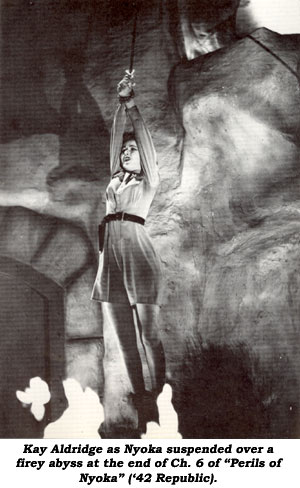
SR: At the end of Ch. 6, “Human Sacrifice”, you are suspended over a blazing abyss. Was that difficult? KA: I was tied up but the tension was taken off under my feet so I wouldn’t just be hanging there except for a little while… but it was scary. I have a freezer burn because they used dry ice to make that smoke. It took some meat off of one leg a little bit. They tried to be thoughtful of us and not draw and quarter us but it was rough. Actually, the serial sort of drove me into matrimony. It was such a beating and I was being pressured by a gentleman to marry him, so it just seemed less dangerous. (Laughs) But I made another serial, “Daredevils of the West”, with Allan Lane.
SR: What was Lane like?
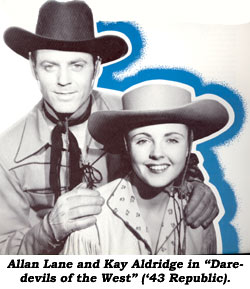 KA: Allan was pretty—and he knew it—if you know what I mean. Allan was handsome, but he was too stuck on himself. My last serial was “Haunted Harbor” made in ‘44, and I worked with that gorgeous Kane Richmond. He was so handsome. That was a very trying time in my life. A friend of mine was killed in the service, my brothers were partially paralyzed, one in an auto accident, one from multiple sclerosis. Also my mother had to have an eye operation. My life was in a turmoil, so I don’t recall much about “Haunted Harbor”. KA: Allan was pretty—and he knew it—if you know what I mean. Allan was handsome, but he was too stuck on himself. My last serial was “Haunted Harbor” made in ‘44, and I worked with that gorgeous Kane Richmond. He was so handsome. That was a very trying time in my life. A friend of mine was killed in the service, my brothers were partially paralyzed, one in an auto accident, one from multiple sclerosis. Also my mother had to have an eye operation. My life was in a turmoil, so I don’t recall much about “Haunted Harbor”.
SR: Following your three serials, you made two films (“Man Who Walked Alone” and “Phantom of 42nd Street”) with Dave O’Brien who had himself worked in several serials, including “Captain Midnight” and “The Black Coin”.
KA: I loved Dave O’Brien. He had the most marvelous personality. He wore a toupee. He had a great sense of humor about himself. He said, “Kay, watch me.” He’d wait til he had an admiring group of girls visiting the set, whispering and looking at him. Then he’d very graciously tip his toupee to them. (Laughs) At night, when he’d go home, after people making a fuss over him at the studio, he told me, “I was quite conceited and my wife noticed it. So, to take me down a peg or two she’d say—Will you take that toupee off and take out the garbage?” He was so much fun.
SR: Backtracking a bit—when you came to Hollywood, weren’t you tested for the role of Scarlett O’Hara for “Gone With the Wind”?
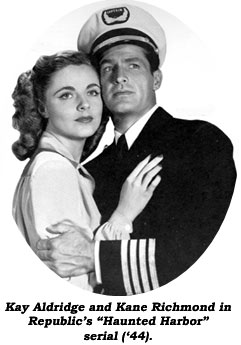 KA: Yes, David Selznick saw my picture on the cover of a magazine and wanted to test me for the part. Unfortunately for me, I didn’t get it. But then I was signed by 20th. KA: Yes, David Selznick saw my picture on the cover of a magazine and wanted to test me for the part. Unfortunately for me, I didn’t get it. But then I was signed by 20th.
The beautiful and gracious star of three of Republic’s absolute best cliffhangers, Kay Aldridge, 77, succumbed to a heart attack on January 12, 1995, in Camden, ME. At the time, “Perils of Nyoka” director Bill Witney told us, “Kay was a sweet, pretty and thoughtful person. She never met a stranger in her life and the crew loved her. One couldn’t help but like Kay. She bore the bumps, bruises, skinned knees and elbows that go with being a serial leading lady without a complaint. She stuck around the set looking over my shoulder long after she was dismissed for the day. She was one helluva gal. I’m sure there is a place in heaven for a beautiful, gutsy, fun loving, caring person like Kay.”

The conclusion of Ch. 4 of “Undersea Kingdom” depicts Crash Corrigan and John Merton being trampled by horses. The start of Ch. 5 shows the horses going around the two men. |

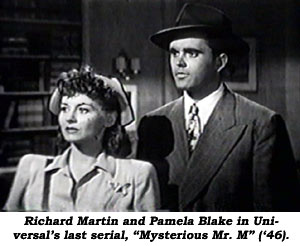 B western sidekicks. Even as a kid I considered the majority of them to be staggeringly unfunny and rarely worthy of the bigger than life heroes they lent minimal support to. Two exceptions for me were Gabby Hayes, who during his career rode with nearly all the greats and had wonderful chemistry with nearly all of them, and Richard Martin as Tim Holt’s RKO pal Chito Rafferty who, unlike most sagebrush companions, could handle a gun, a horse and his fists when the need arose. Martin was not actually Hispanic, but he grew up in a largely Spanish neighborhood and easily (and believably) copied south of the border speech patterns, a fact I noted when catching him in one of Tom Conway’s Falcon films where he portrayed a particularly nasty hoodlum and sounded nothing like Chito. B western sidekicks. Even as a kid I considered the majority of them to be staggeringly unfunny and rarely worthy of the bigger than life heroes they lent minimal support to. Two exceptions for me were Gabby Hayes, who during his career rode with nearly all the greats and had wonderful chemistry with nearly all of them, and Richard Martin as Tim Holt’s RKO pal Chito Rafferty who, unlike most sagebrush companions, could handle a gun, a horse and his fists when the need arose. Martin was not actually Hispanic, but he grew up in a largely Spanish neighborhood and easily (and believably) copied south of the border speech patterns, a fact I noted when catching him in one of Tom Conway’s Falcon films where he portrayed a particularly nasty hoodlum and sounded nothing like Chito.
Universal’s 13 chapter “Mysterious Mr. M” was Martin’s only foray into the cliffhanger genre and almost his only starring vehicle. (He did star in “Adventures of Don Coyote”, a one-off B-western for United Artists in ‘47.) For a serial leading man he is so low key as to almost be invisible (not to mention nearly inaudible) and for the most part takes a backseat to the principal hero, compact, deep-throated Dennis Moore, a familiar face to all serial fans for his work in such cliffhangers as “The Purple Monster Strikes” and “Raiders of Ghost City”.
“Mysterious Mr. M”, directed by Lewis Collins and Vernon Keays, would be the studio’s final cliffhanger. In many respects, with its subdued style, slower pacing and dark, shadowy look, it owes more to low budget mystery thrillers of the period than traditional cliffhangers, although it has its share of action as well. The slightly convoluted—if not occasionally confusing—plot by screenwriters Joseph Poland, Paul Huston and Barry Shipman has federal investigator Grant Farrel (Moore) aided by detective Kirby Walsh (Martin) investigating the disappearance of a famous submarine inventor. What they run into is a scheme—or should I say schemes—hatched by two competing villains out to gain the secrets of the new and revolutionary undersea device with plenty of twists and turns, secret compartments and hypnotic drugs along the way.
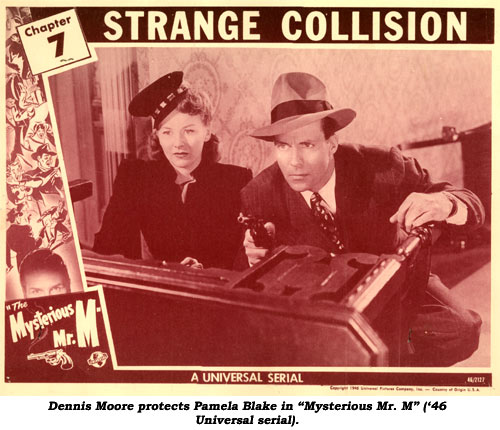
In addition to the aforementioned two heroes, “Mysterious Mr. M” has a strong supporting cast that includes feisty and solid Pamela Blake as the requisite female tagalong, sultry Jane Randolph (of “Cat People” fame) as the bad girl of the piece and Danny Morton, Edmund MacDonald, Jack Ingram, Mauritz Hugo and the always wonderful Byron Foulger as the men in black. Also making what amounted to little more than cameo appearances are John Hamilton of TV’s “Superman” and, in a rare non-villainous role, Anthony Warde.
Most of the cliffhangers in “Mysterious Mr. M” are fairly unremarkable (although the exploding power towers are kinda fun but are stock footage). The miniature work is a cut above most Universal special effects for the simple reason much of the footage was leased from Republic. Even the fistfights are generally an improvement over the studio’s usual poorly choreographed slugfests, but this seems to be a result of Dave Sharpe, Tom Steele and Eddie Parker moonlighting at Universal.
Once again the wonderfully evocative Frank Skinner score borrowed from “Son of Frankenstein”(not to mention all those later Mummy movies) is used to good advantage.
Rather than title cards or the use of a lot of footage from earlier chapters to educate viewers on what’s happened to this point, Universal’s way of recapping in later years was to incorporate new short scenes between various peripheral characters (future serial star Keith Richards for one) to bring audiences up to speed.
If you’re an action fanatic, “Mysterious Mr. M” probably would not rate high on your list of best serials of all time. It’s admittedly a bit talky in spots, but I still enjoyed the performances, the more measured pace and the film noir look of things.
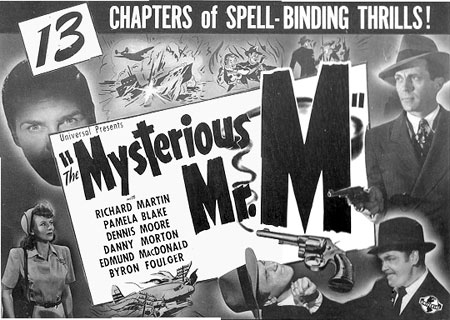

In Ch. 9 of “Mysterious Mr. M”, Dennis Moore is talking with Danny Morton as he opens a booby-trapped box that explodes. In Ch. 10, Moore exits the room without speaking his dialogue while the box explodes with only Morton in the room. |
top of page |


 KA: Allan was pretty—and he knew it—if you know what I mean. Allan was handsome, but he was too stuck on himself. My last serial was “Haunted Harbor” made in ‘44, and I worked with that gorgeous Kane Richmond. He was so handsome. That was a very trying time in my life. A friend of mine was killed in the service, my brothers were partially paralyzed, one in an auto accident, one from multiple sclerosis. Also my mother had to have an eye operation. My life was in a turmoil, so I don’t recall much about “Haunted Harbor”.
KA: Allan was pretty—and he knew it—if you know what I mean. Allan was handsome, but he was too stuck on himself. My last serial was “Haunted Harbor” made in ‘44, and I worked with that gorgeous Kane Richmond. He was so handsome. That was a very trying time in my life. A friend of mine was killed in the service, my brothers were partially paralyzed, one in an auto accident, one from multiple sclerosis. Also my mother had to have an eye operation. My life was in a turmoil, so I don’t recall much about “Haunted Harbor”. KA: Yes, David Selznick saw my picture on the cover of a magazine and wanted to test me for the part. Unfortunately for me, I didn’t get it. But then I was signed by 20th.
KA: Yes, David Selznick saw my picture on the cover of a magazine and wanted to test me for the part. Unfortunately for me, I didn’t get it. But then I was signed by 20th.